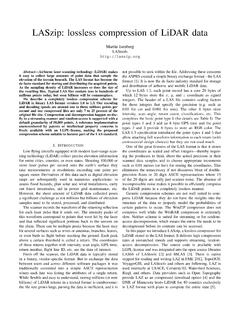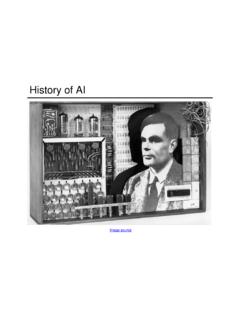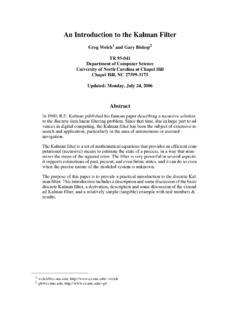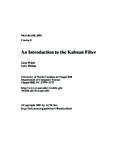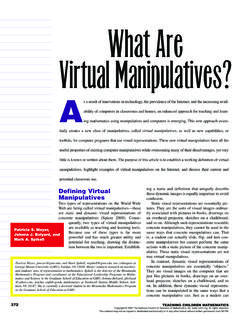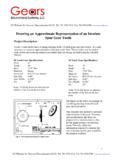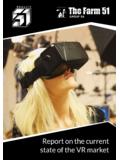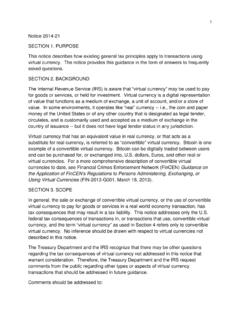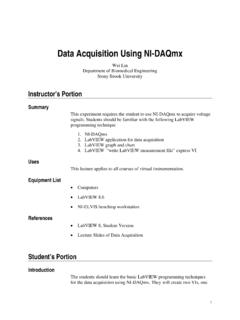Transcription of A Survey of Augmented Reality - Computer Science
1 In Presence: Teleoperators and virtual Environments 6, 4 (August 1997), Survey of Augmented RealityRonald T. AzumaHughes Research Laboratories3011 Malibu Canyon Road, MS RL96 Malibu, CA (310) 317-5151 Fax: (310) 317-5695 AbstractThis paper surveys the field of Augmented Reality , in which 3-D virtualobjects are integrated into a 3-D real environment in real time. It describes themedical, manufacturing, visualization, path planning, entertainment and militaryapplications that have been explored. This paper describes the characteristics ofAugmented Reality systems, including a detailed discussion of the tradeoffs betweenoptical and video blending approaches. Registration and sensing errors are two of thebiggest problems in building effective Augmented Reality systems, so this papersummarizes current efforts to overcome these problems.
2 Future directions and areasrequiring further research are discussed. This Survey provides a starting point foranyone interested in researching or using Augmented paper surveys the current state-of-the-art in Augmented Reality . Itdescribes work performed at many different sites and explains the issues andproblems encountered when building Augmented Reality systems. It summarizes thetradeoffs and approaches taken so far to overcome these problems and speculates onfuture directions that deserve Survey paper does not present new research results. The contribution comesfrom consolidating existing information from many sources and publishing anextensive bibliography of papers in this field. While several other introductorypapers have been written on this subject [Barfield95] [Bowskill95] [Caudell94][Drascic93b] [Feiner94a] [Feiner94b] [Milgram94b] [Rolland94], this Survey is morecomprehensive and up-to-date.
3 This Survey provides a good beginning point foranyone interested in starting research in this 1 describes what Augmented Reality is and the motivations fordeveloping this technology. Six classes of potential applications that have beenexplored are described in Section 2. Then Section 3 discusses the issues involved in2building an Augmented Reality system. Currently, two of the biggest problems are inregistration and sensing: the subjects of Sections 4 and 5. Finally, Section 6 describessome areas that require further work and Reality (AR) is a variation of virtual Environments (VE), orVirtual Reality as it is more commonly called. VE technologies completely immersea user inside a synthetic environment. While immersed, the user cannot see the realworld around him.
4 In contrast, AR allows the user to see the real world, with virtualobjects superimposed upon or composited with the real world. Therefore, ARsupplements Reality , rather than completely replacing it. Ideally, it would appear tothe user that the virtual and real objects coexisted in the same space, similar to theeffects achieved in the film "Who Framed Roger Rabbit?" Figure 1 shows anexample of what this might look like. It shows a real desk with a real phone. Insidethis room are also a virtual lamp and two virtual chairs. Note that the objects arecombined in 3-D, so that the virtual lamp covers the real table, and the real tablecovers parts of the two virtual chairs. AR can be thought of as the "middle ground"between VE (completely synthetic) and telepresence (completely real) [Milgram94a][Milgram94b].
5 Figure 1: Real desk with virtual lamp and two virtual chairs. (Courtesy ECRC)Some researchers define AR in a way that requires the use of Head-MountedDisplays (HMDs). To avoid limiting AR to specific technologies, this Survey definesAR as systems that have the following three characteristics:1) Combines real and virtual2) Interactive in real time3) Registered in 3-DThis definition allows other technologies besides HMDs while retaining theessential components of AR. For example, it does not include film or 2-D like "Jurassic Park" feature photorealistic virtual objects seamlessly blendedwith a real environment in 3-D, but they are not interactive media. 2-D virtualoverlays on top of live video can be done at interactive rates, but the overlays are notcombined with the real world in 3-D.
6 However, this definition does allow monitor-3based interfaces, monocular systems, see-through HMDs, and various othercombining technologies. Potential system configurations are discussed further inSection is Augmented Reality an interesting topic? Why is combining real andvirtual objects in 3-D useful? Augmented Reality enhances a user's perception of andinteraction with the real world. The virtual objects display information that the usercannot directly detect with his own senses. The information conveyed by the virtualobjects helps a user perform real-world tasks. AR is a specific example of what FredBrooks calls Intelligence Amplification (IA): using the Computer as a tool to make atask easier for a human to perform [Brooks96].
7 At least six classes of potential AR applications have been explored: medicalvisualization, maintenance and repair, annotation, robot path planning, entertainment,and military aircraft navigation and targeting. The next section describes work thathas been done in each area. While these do not cover every potential application areaof this technology, they do cover the areas explored so could use Augmented Reality as a visualization and training aid forsurgery. It may be possible to collect 3-D datasets of a patient in real time, usingnon-invasive sensors like Magnetic Resonance Imaging (MRI), ComputedTomography scans (CT), or ultrasound imaging. These datasets could then berendered and combined in real time with a view of the real patient.
8 In effect, thiswould give a doctor "X-ray vision" inside a patient. This would be very useful duringminimally-invasive surgery, which reduces the trauma of an operation by using smallincisions or no incisions at all. A problem with minimally-invasive techniques is thatthey reduce the doctor's ability to see inside the patient, making surgery moredifficult. AR technology could provide an internal view without the need for might also be helpful for general medical visualization tasks in thesurgical room. Surgeons can detect some features with the naked eye that they cannotsee in MRI or CT scans, and vice-versa. AR would give surgeons access to bothtypes of data simultaneously. This might also guide precision tasks, such asdisplaying where to drill a hole into the skull for brain surgery or where to perform aneedle biopsy of a tiny tumor.
9 The information from the non-invasive sensors wouldbe directly displayed on the patient, showing exactly where to perform the might also be useful for training purposes [Kancherla95]. Virtualinstructions could remind a novice surgeon of the required steps, without the need tolook away from a patient to consult a manual. virtual objects could also identifyorgans and specify locations to avoid disturbing [Durlach95].Several projects are exploring this application area. At UNC Chapel Hill, aresearch group has conducted trial runs of scanning the womb of a pregnant womanwith an ultrasound sensor, generating a 3-D representation of the fetus inside thewomb and displaying that in a see-through HMD (Figure 2). The goal is to endowthe doctor with the ability to see the moving, kicking fetus lying inside the womb,with the hope that this one day may become a "3-D stethoscope" [Bajura92][State94].
10 More recent efforts have focused on a needle biopsy of a breast 3 shows a mockup of a breast biopsy operation, where the virtual objectsidentify the location of the tumor and guide the needle to its target [State96b]. Othergroups at the MIT AI Lab [Grimson94] [Grimson95] [Mellor95a] [Mellor95b],General Electric [Lorensen93], and elsewhere [Betting95] [Edwards95] [Taubes94]are investigating displaying MRI or CT data, directly registered onto the 2: virtual fetus inside womb of pregnant patient. (Courtesy UNC ChapelHill Dept. of Computer Science .)Figure 3: Mockup of breast tumor biopsy. 3-D graphics guide needle insertion.(Courtesy UNC Chapel Hill Dept. of Computer Science .) and repair5 Another category of Augmented Reality applications is the assembly,maintenance, and repair of complex machinery.

